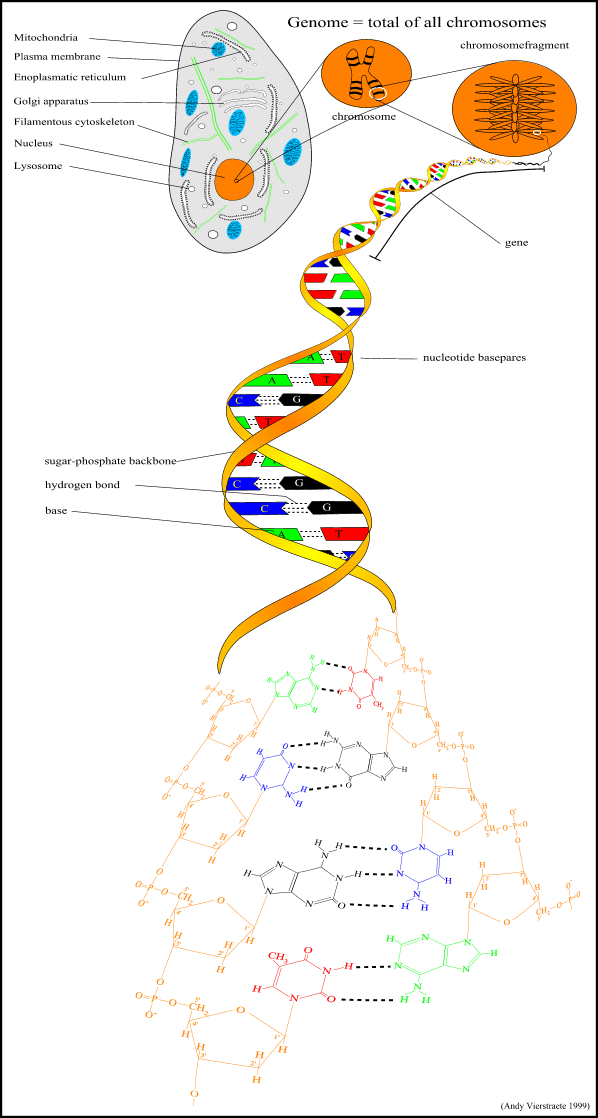(last update : 08-11-1999)
DNA in a cell
1. Which organelles contain DNA ?
Eucariotic cells contain several organelles. The nucleus contains most of the DNA in a cell and this DNA is called the chromosomal DNA. It is separated from the rest of the cell (cytoplasm) by a double layer of membrane. The mitochondria, which have a role in the oxidative degradation of nutrient molecules, also contain DNA, called the mitochondrial DNA. Eucariotic cells that are capable of photosynthesis contain chloroplasts with chloroplast DNA.
Size of genetic material
| Type of DNA |
Organism |
size in base pairs |
| chromosomal DNA |
mammals |
6 x 109 |
| plants |
2 x 108 - 2 x 1011 |
| fungi |
2 x 107 - 2 x 108 |
| mitochondrial DNA |
animals |
16 x 103 - 19 x 103 |
| higher plants |
150 x 103 - 250 x 104 |
| fungi |
17 x 103 - 78 x 103 |
| green alga |
16 x 103 |
| protozoa |
22 x 103 - 40 x 103 |
| chloroplast DNA |
higher plants |
120 x 103 - 200 x 103 |
| green alga |
180 x 103 |
To have an idea of the size of this : every million bases take up a linear space of 0,34 mm. So when you take one human cell, uncoil all the chromosomal DNA and put it on
a line, you would have 204 cm of DNA (a human cell contains in total 6 x 109 nucleotide pairs). To store this information on paper, you need a few pages of A4 paper : one page stores 3100 letters on one side (font courier 12), so 6 x 109 nucleotides, printed on both sides of a sheet, would need 967.742 pages (you'll have a pile of 120,96 m paper !!!). You'd better start printing immediately...

Figure 4 : The DNA in a cell. (pdf file of this picture)
2. There are three types of genes :
- Protein-coding genes : these are transcribed into RNA and then translated into proteins.
- RNA-specifying genes : these are only transcribed into RNA.
- Regulatory genes : according to a narrow definition, these include only untranscribed sequences.
The first two types are also called 'structural genes'.
Figure 5 shows the different parts of the genes that codes for ribosomal RNA (rRNA) (important in protein synthesis (see the Central Dogma figure)). In eucariotic cells, there are 50 – 5000 identical copies of the genes that specify 18S (small sub unit (SSU)), 5.8S and 28S (large sub unit (LSU)) in the 10 million ribosomes. These genes are tandem wise arranged in large blocks on one or more chromosomes and are separated from each other by non transcribed spacer (NTS). These genes are transcribed into a single RNA precursor from which the mature rRNA molecules are released by cleavage. This process removes the external transcribed spacer (ETS), internal transcribed spacer 1 (ITS1) and internal transcribed spacer 2 (ITS2) out of the RNA precursor and results in 3 rRNA molecules : 18S rRNA, 5.8S rRNA and 28S rRNA.

Figure 5 : The genes that encodes for ribosomal RNA.
back to homepage
Next : preparation of DNA

